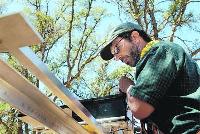
"We want to see how the earth breathes, essentially," he said.
One of the pieces of the climate puzzle that hasn't come into focus yet is this flux of carbon between the earth and the atmosphere. How this interchange will be affected by changes in sunlight, temperature, rainfall and soil moisture is still a big gap in the climate models.
The amount of carbon dioxide in the atmosphere fluctuates over the course of a year as plants go through their annual cycle. In the spring and summer, plants are flowering and growing leaves and taking in carbon dioxide to fuel photosynthesis while giving off oxygen. In the fall and winter, that process slows drastically for some plants and stops altogether for others, leaving more carbon dioxide in the air. Soils also soak up and give off carbon dioxide throughout the year.
The overwhelming scientific consensus is that global warming is inevitable, that it is already happening and that humans are at least partly responsible. But there is far less agreement about how much the earth will warm and how quickly.
Forecasting future climate depends on complicated computer models that require vast amounts of information about everything from how much carbon dioxide is in the atmosphere to how much more sunlight is reflected by sea ice than by the open ocean.
Scientists gather data from the past when they can and make their best estimates when they can't. Though they may never be able to quantify every single force that influences climate, they strive to get as close as possible, and they get closer every day.
Baldocchi is working toward that goal in the oak savanna on ranchland southeast of Sacramento.
"These trees are really amazing in their ability to endure the dry, hot conditions at the end of the summer," he said on a mercifully cool and breezy day in August. The savanna typically gets fewer than 20 inches of rain each year, just enough for the trees to survive.
Baldocchi's team hopes to get as complete a picture as possible of the carbon interchange among plants, soil and air in a typical oak savanna under different climate conditions, particularly extended hot and dry weather. This information then can be used to predict more accurately how Mediterranean savannas across the globe, which make up around 20 percent of the earth's groundcover, will react to future climate change.
"We want to see what's going on on the ground and then compare that to what the satellites see and then extrapolate to the rest of the earth," Baldocchi said.
Meanwhile, at 300 other sites across the globe, scientists are gathering the same information from different types of plants. The international project, known as Fluxnet, aims to understand how different ecosystems breathe by making continuous measurements for multiple years. The data they gather can then be plugged into global climate models to help them get closer to reality.
"They need to be able to calculate the flows of energy in and out of the ecosystem," Baldocchi said.
He has employed an army of instruments and several graduate students to probe and scrutinize the savanna from the roots up to the top of the oak canopy. By recording temperature, sunlight, carbon dioxide, water vapor, vertical and horizontal wind velocities and air turbulence, they are slowly teasing apart the intricate relationship between the earth and the atmosphere.
At the top of the metal tower above the oak canopy, instruments measure the amount of sunlight coming in. Below the trees and a few feet above the ground, a bread-box sized robot glides back and forth along a 30-meter track through patches of sun and shade, measuring how much sunlight gets through the leaves to the grass below. Another instrument on the tower measures how much light is reflected back up from the ground.
A network of tubes collects air samples from different heights along the tower to be analyzed for carbon dioxide. The carbon coming from the atmosphere, the ground and the plants has different ratios of carbon isotopes -- or forms of carbon with slightly different masses -- which scientists can use to determine where the carbon dioxide is coming from and where it is going.
"You have CO2 being taken up by plants and being respirated into the atmosphere," said biogeochemist Rich Brenner of UC Berkeley. "It's basically the ratio that tells us if the CO2 is coming from the ground or plants or being taken up by the plants."
Graduate student Jessica Osuna has set up another contraption to analyze the efficiency of photosynthesis in an oak tree's leaves by comparing the carbon dioxide in the air flowing around the leaf to the ambient air. The more the leaf photosynthesizes, the less carbon will be left in the air around it.
Eventually, Baldocchi's team and other scientists doing similar measurements around the world aim to have a detailed grasp of when, how and how much carbon flows in and out of different ecosystems. This picture will put climate scientists one step closer to understanding what the future holds.
--By Betsy Mason
CONTRA COSTA TIMES
Original URL
